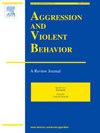Person-centered approaches for dating violence among adolescents and young adults: A systematic review
IF 3.4
2区 心理学
Q1 CRIMINOLOGY & PENOLOGY
引用次数: 0
Abstract
An increasing number of studies have documented the heterogeneous nature of dating violence among youth using person-centered approaches. These studies have identified distinct subgroups of individuals who share similarities in their experiences with different forms of dating violence. Identifying dating violence classes is an essential first step for informing prevention and to guide future research. The current systematic review aimed to examine and synthesize the literature on person-centered approaches on dating violence among adolescents and young adults as well as to identify sex or gender differences. Five databases were searched to identify peer-reviewed studies (2000−2022) and theses (2015–2022) written in French, English, or Spanish, with participants aged 11 to 25. Only studies using latent class or latent profile analyses on dating violence victimization and/or perpetration (psychological, physical, and/or sexual) with at least two forms of violence were included. Drawn from 22 studies, findings highlight four typical classes of dating violence: a little or no involvement class (the largest class), a psychological violence class (typically the second largest class), a psychological and physical violence class and a multiple forms of violence class. Results on sex or gender differences are mixed. Similar numbers of classes were generally identified for boys and girls, although two studies found a greater number of classes for girls. Variations in the operationalization of dating violence limit result comparability. Nonetheless, results highlight that prevention should focus on psychological violence, as nearly all individuals involved in dating violence are involved in this form of violence.
以人为中心的方法在青少年和年轻成人约会暴力:系统回顾
越来越多的研究使用以人为中心的方法记录了青少年约会暴力的异质性。这些研究已经确定了不同的亚群体,他们在不同形式的约会暴力中有着相似的经历。确定约会暴力类别是告知预防和指导未来研究的重要第一步。当前的系统综述旨在检查和综合有关以人为中心的方法研究青少年和年轻人约会暴力的文献,并确定性别或性别差异。检索了5个数据库,以确定同行评议的研究(2000 - 2022)和用法语、英语或西班牙语撰写的论文(2015-2022),参与者年龄在11至25岁之间。仅包括对约会暴力受害和/或犯罪(心理、身体和/或性)至少两种形式的暴力使用潜在类别或潜在特征分析的研究。根据22项研究,研究结果突出了约会暴力的四种典型类型:很少或没有参与类(最大的一类),心理暴力类(通常是第二大类),心理和身体暴力类以及多种形式的暴力类。性别差异的研究结果喜忧参半。一般来说,男孩和女孩的班级数量差不多,尽管有两项研究发现女孩的班级数量更多。约会暴力的操作变化限制了结果的可比性。尽管如此,研究结果强调,预防应侧重于心理暴力,因为几乎所有参与约会暴力的个人都参与了这种形式的暴力。
本文章由计算机程序翻译,如有差异,请以英文原文为准。
求助全文
约1分钟内获得全文
求助全文
来源期刊

Aggression and Violent Behavior
Multiple-
CiteScore
7.50
自引率
4.30%
发文量
63
期刊介绍:
Aggression and Violent Behavior, A Review Journal is a multidisciplinary journal that publishes substantive and integrative reviews, as well as summary reports of innovative ongoing clinical research programs on a wide range of topics germane to the field of aggression and violent behavior. Papers encompass a large variety of issues, populations, and domains, including homicide (serial, spree, and mass murder: sexual homicide), sexual deviance and assault (rape, serial rape, child molestation, paraphilias), child and youth violence (firesetting, gang violence, juvenile sexual offending), family violence (child physical and sexual abuse, child neglect, incest, spouse and elder abuse), genetic predispositions, and the physiological basis of aggression.
 求助内容:
求助内容: 应助结果提醒方式:
应助结果提醒方式:


